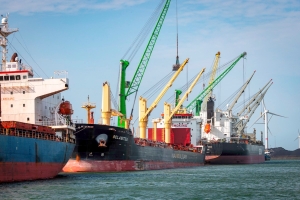


(Posted on 20/01/25)
In 2024, the North Sea Port companies recorded a volume of 66.3 million tons of seaborne cargo transhipment, an increase of 0.7% compared to 2023. Inland navigation rose by 4.4%. These increases are encouraging in themselves, but especially so given current economic and geopolitical developments.
Seaborne transhipment increased by 0.4 million tons of goods compared to the serious dip in 2023. This slight improvement is due to North Sea Port's distinctive profile as a bulk port: dry bulk and break bulk (general cargo) throughput increased significantly. The diversification of activities at the port often provides a counterbalance in uncertain times – on the other side of the scale, liquid bulk transhipment fell. The decline of specific products linked to a (cautious) industrial sector is making its impact felt in the port.
Seaborne transhipment with Great Britain actually increased by more than a quarter, making it the number one trading partner. The impact of Brexit seems to be a thing of the past in terms of tons of goods transhipment, and North Sea Port continues to strengthen its role as a port firmly positioned in the heart of Europe.
Inland waterway transhipment is prospering, posting growth of just under 5%. North Sea Port’s ideal location at the intersection of Western European inland waterways, excellent port infrastructure and modal shift projects aimed at transporting more goods via inland waterways are boosting this sustainable form of transport. And, not least, the distinctive nature of the products handled in the port – specifically bulk goods – lends itself perfectly to inland navigation.
The challenges for the years ahead are many – certainly on the geopolitical front, with the Russia-Ukraine war and ongoing tensions in the Middle East, as well as the United States and possible trade barriers. In addition, there has been a slowdown in the energy transition and there remains an urgent need for a level and competitive playing field within Europe and a European Industrial Deal.
However, North Sea Port looks forward to significant investment in the coming years. The raft of upcoming investments for 2025 in the energy, offshore, logistics and circularity sectors offer the prospect of additional jobs and additional financial security for the port authority. North Sea Port expects to release 30 hectares of land by 2025, the same amount as in 2024.
North Sea Port remains, above all, a bulk port. Dry and liquid bulk still make up a full three quarters of transhipment. Dry bulk increased again (+2.1%) and continues to account for more than half (54%) of all transhipment (35.9 million tons). The rise was the result of increased supplies of iron ore, wood pellets, chemicals and soya beans. The transhipment of construction materials kept pace, while that of rapeseed decreased.
Break bulk also grew (+7%) and continues to represent 15% of throughput (10.2 million tons). Within that figure, cellulose transhipment increased, while sheet steel decreased.
Peel Ports Group has achieved a 48% reduction in operational greenhouse gas emissions in the last five... Read more
The Trois-Rivières Port Authority (TRPA) in Canada has announced the appointment of Mr. Anick... Read more
Euroports commitment to continuously improving operational efficiency, enhancing workplace safety, and... Read more
Under the slogan ‘Your Intermodal Link Between China, Iberia and the Atlantic Markets,’... Read more
Port of Hamburg Marketing (HHM) continues to strengthen its successful cooperation with Chinese port... Read more
Total throughput in the port of Rotterdam fell slightly by 2.6% in the third quarter of 2025 compared... Read more
E-Crane Asia has announced a major milestone achieved by Bayan in Indonesia: the company’s three... Read more
PD Ports has successfully introduced fully automated weighbridge systems at Teesport and Hartlepool,... Read more
In the first nine months of 2025, Port of Antwerp-Bruges handled 202.6 million tonnes of maritime goods... Read more
The 90th General Assembly of the inland shipping cooperative NPRC has highlighted the importance of... Read more